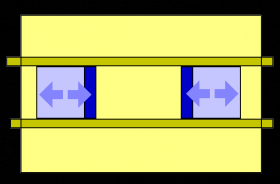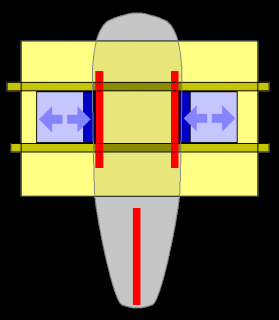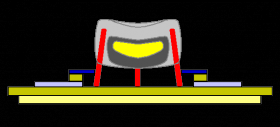uitlijnmal voor alleweder enz.
Gecreëerd op 21 januari 2012 14:24
Categorieën: Techniek, Sturen
(English text below)
----------------------------------------
De voorwielen van een Alleweder moeten goed sporen. Dit betekent dat ze tijdens het rijden evenwijdig moeten staan. Als de sporing niet klopt loopt de fiets zwaarder en de banden slijten sneller.
De uitlijning kan alleen goed worden gecontroleerd als de berijder in de fiets zit. Als je het in je eentje wilt doen kan het behoorlijk lastig zijn.
Nadat ik mijn voorwielen een keer verkeerd had uitgelijnd - en in 400 km een paar nieuwe banden tot de draad versleten - heb ik deze mal gemaakt. Hij hoeft niet duur te zijn, ik heb hem gemaakt van een paar platen en latten die over waren van een verbouwing.
De maten zijn niet kritisch, het is natuurlijk wel van belang dat de platen haaks zijn en de latten evenwijdig zijn.
Als je de mal wilt gebruiken voor een Quest moet je de oppassen dat je de opstaande delen niet te hoog maakt. Een Mango past waarschijnlijk zonder aanpassing.
Het gebruik is makkelijk. Vanuit de Alleweder kun je overal goed bij.
Je wielen moeten recht zijn, anders werkt de uitlijning natuurlijk niet.....
(1) Zet de Alleweder met de voorwielen tussen de latten, zorg dat de lengte-as van de fiets haaks op de latten staat.
(2) Ga in de Alleweder zitten.
(3) Schuif de platen (met de pijlen) tegen de wielen en controleer of alles evenwijdig loopt.
(4) Stel de wielen zonodig bij. Als je de wielen niet helemaal evenwijdig krijgt, stel ze dan in met toespoor. Dit is hoogstens een paar millimeter en tijdens het rijden wordt het toespoor opgeheven door de speling in de voortrein.
Tekening 1 is de uitlijnmal.
Tekening 2 is het bovenaanzicht met Alleweder.
Tekening 3 is het vooraanzicht met Alleweder.
(de tekeningen zijn schematisch)
----------------------------------------
The front wheels of an Alleweder have to be aligned correctly. This means that they must be parallel when the vehicle is moving. When the alignment is incorrect, the cycle runs less fast and the tyres wear out more quickly. The alignment can only be checked correctly when the rider is in the seat. If you want to do this check all on your own, it can be a tricky job ant the results may not be correct.
After having aligned my wheels incorrectly - and wearing a pair of new tyres down to the canvas in just 400 km - I have made this alignment gauge. It doesn't need to be an expensive affair, mine was made from a few boards and planks left over from a job on my house.
The sizes are not very critical, but of course it is important that the boards have right angles and that the planks are mounted parallel.
If you want to use this gauge for a Quest, make sure that the rising parts are not too high. A Mango will probably fit without changes in this construction.
Using the gauge is straightforward. You can reach all parts well when sitting in the Alleweder. Of course, your wheels must not be warped. If they are, the alignment may not work.....
(1) Put the Alleweder on the baseboard with the front wheels between the planks, make sure that the longitudinal axis of the tricycle makes a square angle to these. Ideally the rear wheel is on the same baseboard, otherwise you will want to put something under the wheel to make up for this. (2) Get in the seat of the Alleweder. (3) Slide the boards (with the arrows) against the wheels and check if everything is parallel. (4) If necessary, adjust the alignment of the wheels. If you cannot get the wheels exactly parallel, then adjust them so that there is a little toe-in. This will be a few millimeters at most and during the ride the toe-in will disappear because of the slack in the steering mechanism.
Sketch 1 is the alignment gauge. Sketch 2 is a view from above with the Alleweder in place. Sketch 3 is a front sight with Alleweder.
(the sketches are schematic only)









Reacties (0)